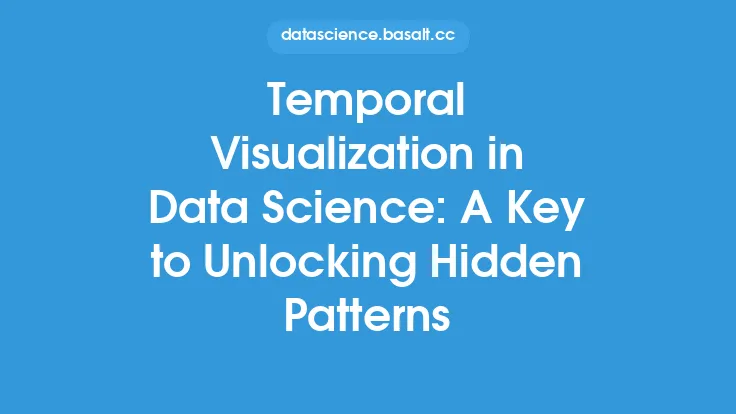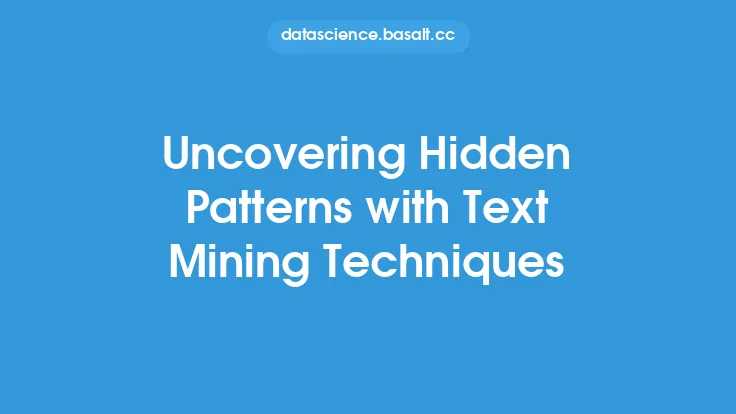Cluster analysis is a multivariate statistical technique used to identify and group similar observations, objects, or individuals into clusters based on their characteristics. This technique is widely used in various fields, including data mining, machine learning, marketing, and social sciences, to uncover hidden patterns and structures in data. The primary goal of cluster analysis is to identify homogeneous groups of objects that are similar to each other and distinct from objects in other groups.
What is Cluster Analysis?
Cluster analysis is an exploratory data analysis technique that involves partitioning a set of observations into clusters based on their similarities and differences. The technique is often used to identify patterns, relationships, and groupings in data that may not be immediately apparent. Cluster analysis can be applied to various types of data, including numerical, categorical, and mixed data. The technique is particularly useful when dealing with large datasets, as it helps to reduce the complexity of the data and identify meaningful patterns and relationships.
Types of Cluster Analysis
There are several types of cluster analysis techniques, including hierarchical clustering, k-means clustering, density-based clustering, and model-based clustering. Hierarchical clustering involves creating a hierarchy of clusters by merging or splitting existing clusters. K-means clustering involves partitioning the data into a fixed number of clusters based on the mean distance of the objects from the cluster center. Density-based clustering involves identifying clusters as areas of high density in the data. Model-based clustering involves using statistical models to identify clusters and assign objects to them.
Applications of Cluster Analysis
Cluster analysis has a wide range of applications in various fields, including marketing, customer segmentation, gene expression analysis, image segmentation, and social network analysis. In marketing, cluster analysis is used to segment customers based on their demographic, behavioral, and transactional characteristics. In gene expression analysis, cluster analysis is used to identify groups of genes that are co-expressed and may be involved in similar biological processes. In image segmentation, cluster analysis is used to identify regions of an image that have similar characteristics, such as texture or color. In social network analysis, cluster analysis is used to identify groups of individuals who are closely connected and may share similar interests or characteristics.
Cluster Analysis Techniques
Several techniques are used in cluster analysis, including distance measures, clustering algorithms, and evaluation metrics. Distance measures, such as Euclidean distance and Manhattan distance, are used to calculate the similarity between objects. Clustering algorithms, such as k-means and hierarchical clustering, are used to partition the data into clusters. Evaluation metrics, such as silhouette coefficient and Calinski-Harabasz index, are used to evaluate the quality of the clusters and determine the optimal number of clusters.
Distance Measures
Distance measures are used to calculate the similarity between objects in cluster analysis. The choice of distance measure depends on the type of data and the clustering algorithm used. Common distance measures include Euclidean distance, Manhattan distance, and cosine similarity. Euclidean distance is a popular distance measure that calculates the straight-line distance between two objects. Manhattan distance, also known as city block distance, calculates the distance between two objects as the sum of the absolute differences in their coordinates. Cosine similarity measures the cosine of the angle between two vectors and is often used in text analysis and information retrieval.
Clustering Algorithms
Clustering algorithms are used to partition the data into clusters based on the distance measures and other criteria. Common clustering algorithms include k-means, hierarchical clustering, and density-based clustering. K-means clustering is a popular algorithm that partitions the data into a fixed number of clusters based on the mean distance of the objects from the cluster center. Hierarchical clustering creates a hierarchy of clusters by merging or splitting existing clusters. Density-based clustering identifies clusters as areas of high density in the data.
Evaluation Metrics
Evaluation metrics are used to evaluate the quality of the clusters and determine the optimal number of clusters. Common evaluation metrics include silhouette coefficient, Calinski-Harabasz index, and Davies-Bouldin index. Silhouette coefficient measures the separation between clusters and the cohesion within clusters. Calinski-Harabasz index measures the ratio of between-cluster variance to within-cluster variance. Davies-Bouldin index measures the similarity between clusters based on their centroid distances and scatter within the clusters.
Challenges and Limitations
Cluster analysis has several challenges and limitations, including the choice of distance measure, the selection of clustering algorithm, and the evaluation of cluster quality. The choice of distance measure depends on the type of data and the clustering algorithm used. The selection of clustering algorithm depends on the characteristics of the data and the goals of the analysis. The evaluation of cluster quality is challenging due to the subjective nature of clustering and the lack of a universal evaluation metric.
Real-World Examples
Cluster analysis has numerous real-world applications, including customer segmentation, gene expression analysis, image segmentation, and social network analysis. For example, a company may use cluster analysis to segment its customers based on their demographic, behavioral, and transactional characteristics. A researcher may use cluster analysis to identify groups of genes that are co-expressed and may be involved in similar biological processes. An image analyst may use cluster analysis to identify regions of an image that have similar characteristics, such as texture or color. A social network analyst may use cluster analysis to identify groups of individuals who are closely connected and may share similar interests or characteristics.
Best Practices
Best practices for cluster analysis include selecting the appropriate distance measure and clustering algorithm, evaluating the quality of the clusters, and interpreting the results in the context of the research question or business problem. The selection of distance measure and clustering algorithm depends on the characteristics of the data and the goals of the analysis. The evaluation of cluster quality is critical to ensure that the clusters are meaningful and useful. The interpretation of the results requires a deep understanding of the data, the research question or business problem, and the limitations of cluster analysis.
Future Directions
The future of cluster analysis is exciting and rapidly evolving, with new techniques and applications emerging in various fields. The increasing availability of large datasets and the development of new clustering algorithms and evaluation metrics are expected to drive the growth of cluster analysis in the coming years. The integration of cluster analysis with other data analysis techniques, such as machine learning and deep learning, is expected to lead to new insights and applications in various fields. The development of new evaluation metrics and the improvement of existing ones are expected to enhance the quality and reliability of cluster analysis results.





